Medical Surgical Nursing Assignment: John Doe's Care Plan - Tasks 1-4
VerifiedAdded on 2021/04/21
|11
|3325
|74
Homework Assignment
AI Summary
This assignment presents a comprehensive medical-surgical nursing care plan for a patient named John Doe. It begins with an assessment of John's condition, including hypertension, potential infection, and wound assessment, emphasizing the interconnectedness of these issues and their impact on the patient's physical, psychological, and physiological well-being. The care plan then details specific nursing interventions for addressing infection (related to a foot wound), wound healing, and pain management. It includes goals of care, nursing interventions, and rationales for each problem, alongside evaluation criteria. The plan covers antibiotic administration, wound cleaning, pain assessment, and medication management, including gentamicin and ibuprofen. The assignment also includes discussions on nutritional needs, respiratory support, and anxiety management. Finally, it suggests additional assessments, such as a chest X-ray, to rule out complications like pulmonary edema, and provides a detailed overview of the patient's overall care and treatment.
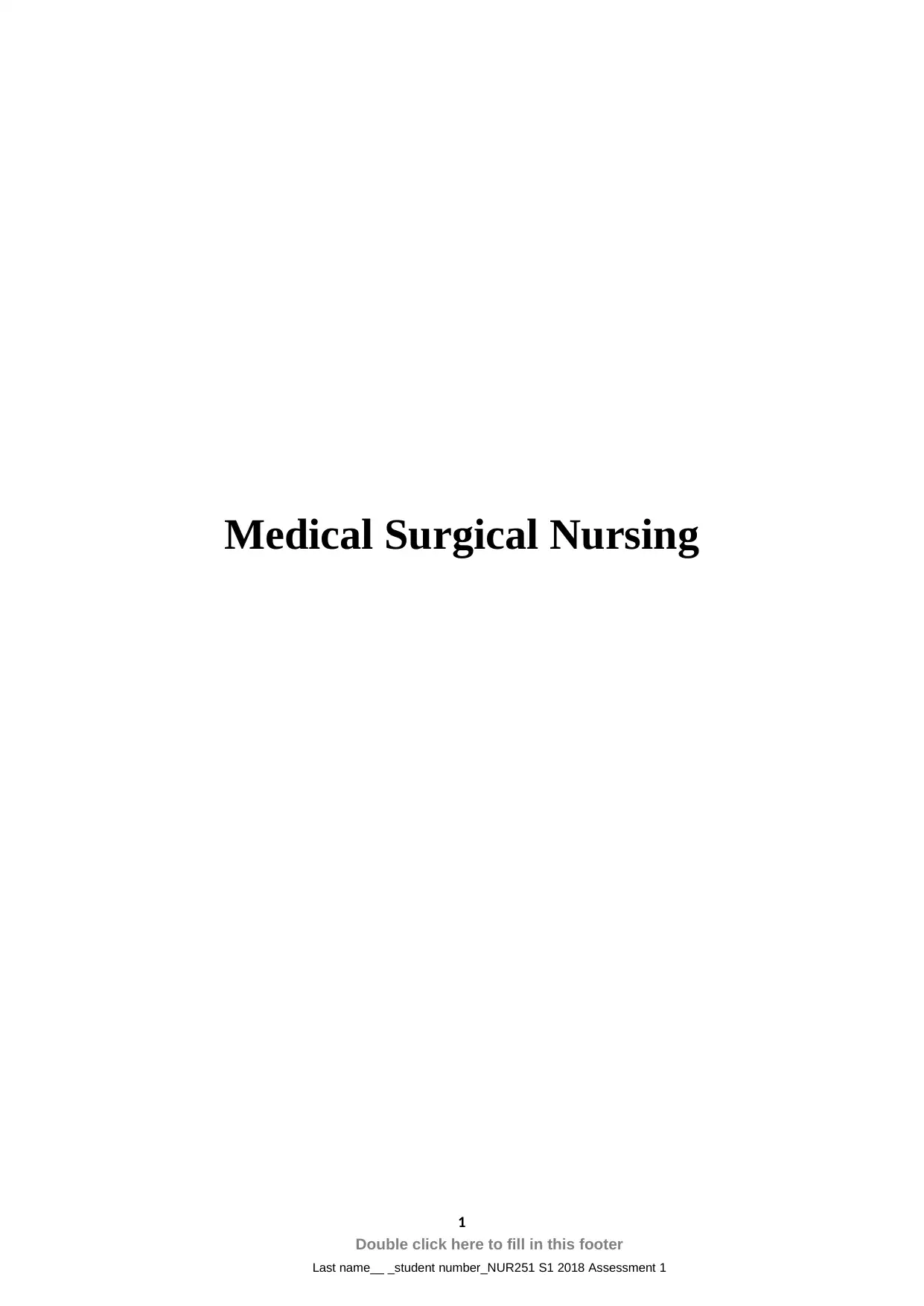
Medical Surgical Nursing
1
Double click here to fill in this footer
Last name__ _student number_NUR251 S1 2018 Assessment 1
1
Double click here to fill in this footer
Last name__ _student number_NUR251 S1 2018 Assessment 1
Paraphrase This Document
Need a fresh take? Get an instant paraphrase of this document with our AI Paraphraser
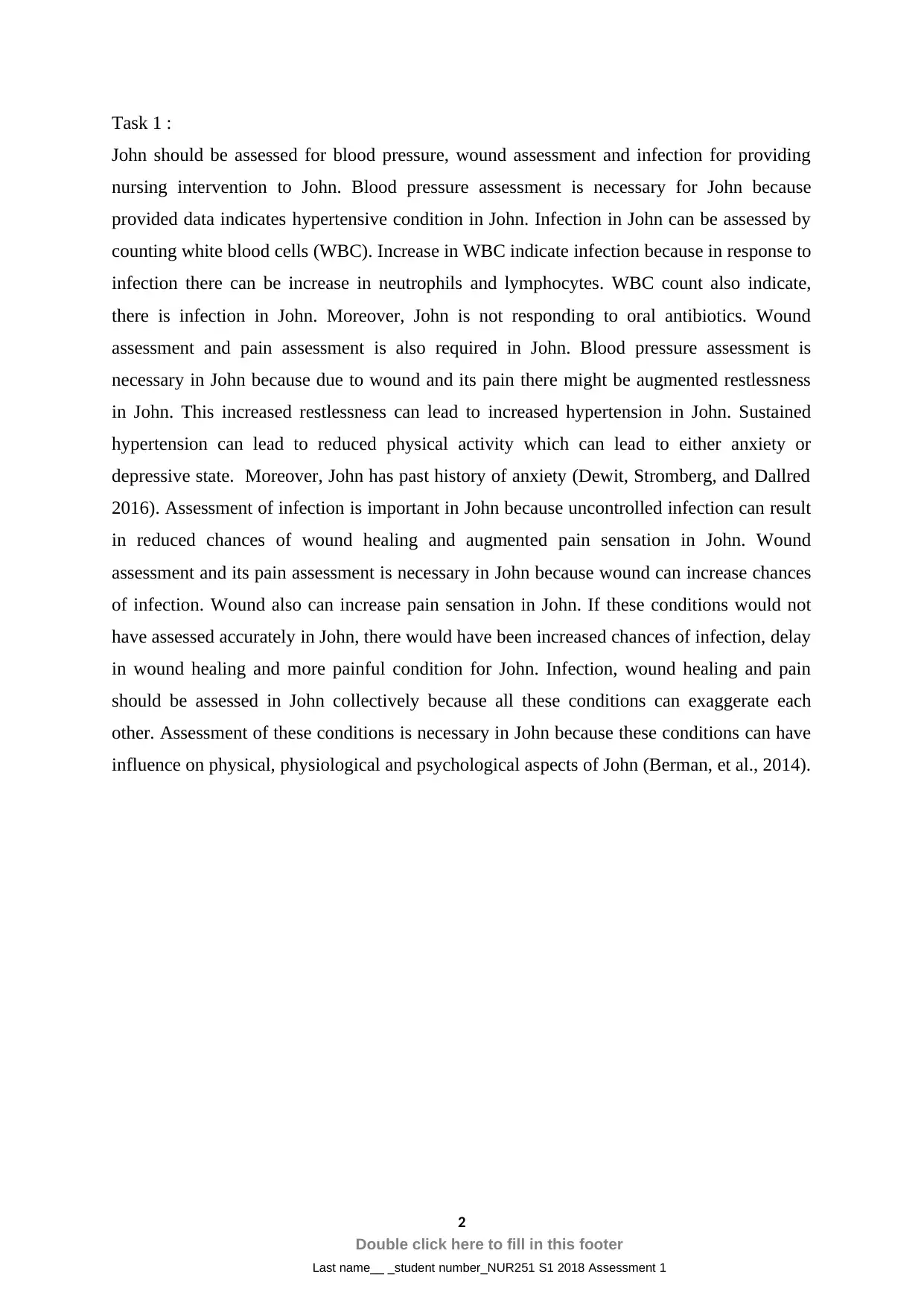
Task 1 :
John should be assessed for blood pressure, wound assessment and infection for providing
nursing intervention to John. Blood pressure assessment is necessary for John because
provided data indicates hypertensive condition in John. Infection in John can be assessed by
counting white blood cells (WBC). Increase in WBC indicate infection because in response to
infection there can be increase in neutrophils and lymphocytes. WBC count also indicate,
there is infection in John. Moreover, John is not responding to oral antibiotics. Wound
assessment and pain assessment is also required in John. Blood pressure assessment is
necessary in John because due to wound and its pain there might be augmented restlessness
in John. This increased restlessness can lead to increased hypertension in John. Sustained
hypertension can lead to reduced physical activity which can lead to either anxiety or
depressive state. Moreover, John has past history of anxiety (Dewit, Stromberg, and Dallred
2016). Assessment of infection is important in John because uncontrolled infection can result
in reduced chances of wound healing and augmented pain sensation in John. Wound
assessment and its pain assessment is necessary in John because wound can increase chances
of infection. Wound also can increase pain sensation in John. If these conditions would not
have assessed accurately in John, there would have been increased chances of infection, delay
in wound healing and more painful condition for John. Infection, wound healing and pain
should be assessed in John collectively because all these conditions can exaggerate each
other. Assessment of these conditions is necessary in John because these conditions can have
influence on physical, physiological and psychological aspects of John (Berman, et al., 2014).
2
Double click here to fill in this footer
Last name__ _student number_NUR251 S1 2018 Assessment 1
John should be assessed for blood pressure, wound assessment and infection for providing
nursing intervention to John. Blood pressure assessment is necessary for John because
provided data indicates hypertensive condition in John. Infection in John can be assessed by
counting white blood cells (WBC). Increase in WBC indicate infection because in response to
infection there can be increase in neutrophils and lymphocytes. WBC count also indicate,
there is infection in John. Moreover, John is not responding to oral antibiotics. Wound
assessment and pain assessment is also required in John. Blood pressure assessment is
necessary in John because due to wound and its pain there might be augmented restlessness
in John. This increased restlessness can lead to increased hypertension in John. Sustained
hypertension can lead to reduced physical activity which can lead to either anxiety or
depressive state. Moreover, John has past history of anxiety (Dewit, Stromberg, and Dallred
2016). Assessment of infection is important in John because uncontrolled infection can result
in reduced chances of wound healing and augmented pain sensation in John. Wound
assessment and its pain assessment is necessary in John because wound can increase chances
of infection. Wound also can increase pain sensation in John. If these conditions would not
have assessed accurately in John, there would have been increased chances of infection, delay
in wound healing and more painful condition for John. Infection, wound healing and pain
should be assessed in John collectively because all these conditions can exaggerate each
other. Assessment of these conditions is necessary in John because these conditions can have
influence on physical, physiological and psychological aspects of John (Berman, et al., 2014).
2
Double click here to fill in this footer
Last name__ _student number_NUR251 S1 2018 Assessment 1

Task 2 A
Nursing Care Plan: John Doe
Nursing problem: Infection
Related to: John cut his foot on Oyster shell. Due to this, he got injury and consequently
Infection.
Goal of care Nursing interventions Rationale Evaluation
There should not be
spread of infection.
Infection should be
controlled or
diminished.
Wound should be regularly cleaned with
antiseptic solution and it should be covered
with sterile dressing.
Antibiotic should be administered through
suitable route of like oral, preantral or
topical.
Cleaning of wound with antiseptic
solution would result in bactericidal or
bacteriostatic action at wound place
Ridley, 2015).
Based on the suitability and
responsiveness of antibiotic, route of
antibiotic administration should be
selected. In case of John, oral antibiotic
is not exhibiting positive response
hence antibiotic should be administered
through intravenous route (Ridley,
2015).
White blood cell count should be determined
in John.
Specimens should be submitted for the
identification of bacteria.
Nursing problem: Wound
Related to: John cut his foot on Oyster shell. Due to this, he got injury and results in the wound.
Goal of care Nursing interventions Rationale Evaluation
Complete healing of the
wound and prevention
of injury.
Color, temperature, edema, moisture and
appearance of the skin around the wound
should be monitored.
Integrity of inured tissue should be
monitored for signs of infection.
Systematic inspection can be helpful in
identifying potential problems due to
infection (Martin and Nunan, 2015;
Berg, Fleischer, Kuss et al., 2012).
Area around skin remain intact without
inflammation.
3
Double click here to fill in this footer
Last name__ _student number_NUR251 S1 2018 Assessment 1
Nursing Care Plan: John Doe
Nursing problem: Infection
Related to: John cut his foot on Oyster shell. Due to this, he got injury and consequently
Infection.
Goal of care Nursing interventions Rationale Evaluation
There should not be
spread of infection.
Infection should be
controlled or
diminished.
Wound should be regularly cleaned with
antiseptic solution and it should be covered
with sterile dressing.
Antibiotic should be administered through
suitable route of like oral, preantral or
topical.
Cleaning of wound with antiseptic
solution would result in bactericidal or
bacteriostatic action at wound place
Ridley, 2015).
Based on the suitability and
responsiveness of antibiotic, route of
antibiotic administration should be
selected. In case of John, oral antibiotic
is not exhibiting positive response
hence antibiotic should be administered
through intravenous route (Ridley,
2015).
White blood cell count should be determined
in John.
Specimens should be submitted for the
identification of bacteria.
Nursing problem: Wound
Related to: John cut his foot on Oyster shell. Due to this, he got injury and results in the wound.
Goal of care Nursing interventions Rationale Evaluation
Complete healing of the
wound and prevention
of injury.
Color, temperature, edema, moisture and
appearance of the skin around the wound
should be monitored.
Integrity of inured tissue should be
monitored for signs of infection.
Systematic inspection can be helpful in
identifying potential problems due to
infection (Martin and Nunan, 2015;
Berg, Fleischer, Kuss et al., 2012).
Area around skin remain intact without
inflammation.
3
Double click here to fill in this footer
Last name__ _student number_NUR251 S1 2018 Assessment 1
⊘ This is a preview!⊘
Do you want full access?
Subscribe today to unlock all pages.

Trusted by 1+ million students worldwide
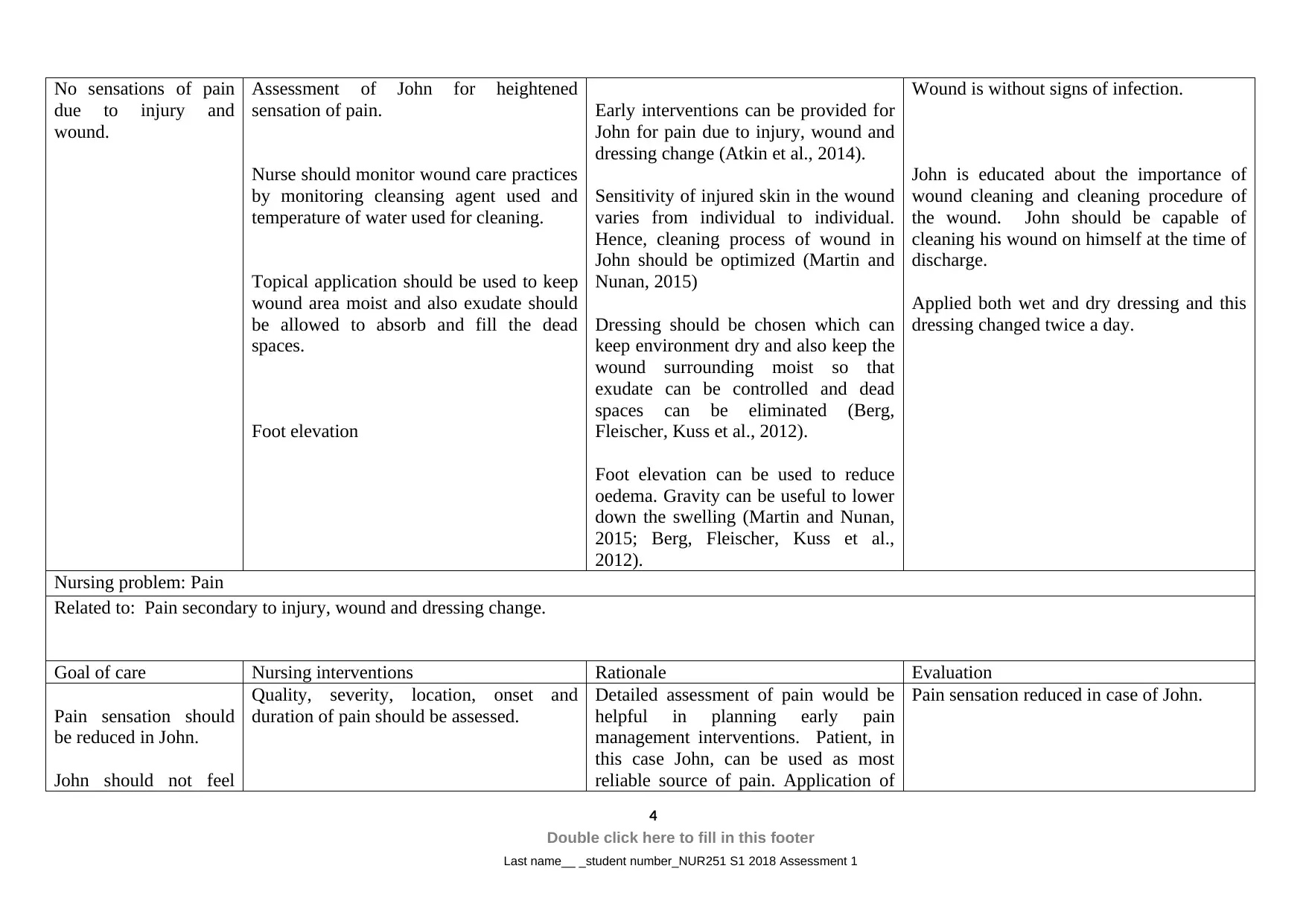
No sensations of pain
due to injury and
wound.
Assessment of John for heightened
sensation of pain.
Nurse should monitor wound care practices
by monitoring cleansing agent used and
temperature of water used for cleaning.
Topical application should be used to keep
wound area moist and also exudate should
be allowed to absorb and fill the dead
spaces.
Foot elevation
Early interventions can be provided for
John for pain due to injury, wound and
dressing change (Atkin et al., 2014).
Sensitivity of injured skin in the wound
varies from individual to individual.
Hence, cleaning process of wound in
John should be optimized (Martin and
Nunan, 2015)
Dressing should be chosen which can
keep environment dry and also keep the
wound surrounding moist so that
exudate can be controlled and dead
spaces can be eliminated (Berg,
Fleischer, Kuss et al., 2012).
Foot elevation can be used to reduce
oedema. Gravity can be useful to lower
down the swelling (Martin and Nunan,
2015; Berg, Fleischer, Kuss et al.,
2012).
Wound is without signs of infection.
John is educated about the importance of
wound cleaning and cleaning procedure of
the wound. John should be capable of
cleaning his wound on himself at the time of
discharge.
Applied both wet and dry dressing and this
dressing changed twice a day.
Nursing problem: Pain
Related to: Pain secondary to injury, wound and dressing change.
Goal of care Nursing interventions Rationale Evaluation
Pain sensation should
be reduced in John.
John should not feel
Quality, severity, location, onset and
duration of pain should be assessed.
Detailed assessment of pain would be
helpful in planning early pain
management interventions. Patient, in
this case John, can be used as most
reliable source of pain. Application of
Pain sensation reduced in case of John.
4
Double click here to fill in this footer
Last name__ _student number_NUR251 S1 2018 Assessment 1
due to injury and
wound.
Assessment of John for heightened
sensation of pain.
Nurse should monitor wound care practices
by monitoring cleansing agent used and
temperature of water used for cleaning.
Topical application should be used to keep
wound area moist and also exudate should
be allowed to absorb and fill the dead
spaces.
Foot elevation
Early interventions can be provided for
John for pain due to injury, wound and
dressing change (Atkin et al., 2014).
Sensitivity of injured skin in the wound
varies from individual to individual.
Hence, cleaning process of wound in
John should be optimized (Martin and
Nunan, 2015)
Dressing should be chosen which can
keep environment dry and also keep the
wound surrounding moist so that
exudate can be controlled and dead
spaces can be eliminated (Berg,
Fleischer, Kuss et al., 2012).
Foot elevation can be used to reduce
oedema. Gravity can be useful to lower
down the swelling (Martin and Nunan,
2015; Berg, Fleischer, Kuss et al.,
2012).
Wound is without signs of infection.
John is educated about the importance of
wound cleaning and cleaning procedure of
the wound. John should be capable of
cleaning his wound on himself at the time of
discharge.
Applied both wet and dry dressing and this
dressing changed twice a day.
Nursing problem: Pain
Related to: Pain secondary to injury, wound and dressing change.
Goal of care Nursing interventions Rationale Evaluation
Pain sensation should
be reduced in John.
John should not feel
Quality, severity, location, onset and
duration of pain should be assessed.
Detailed assessment of pain would be
helpful in planning early pain
management interventions. Patient, in
this case John, can be used as most
reliable source of pain. Application of
Pain sensation reduced in case of John.
4
Double click here to fill in this footer
Last name__ _student number_NUR251 S1 2018 Assessment 1
Paraphrase This Document
Need a fresh take? Get an instant paraphrase of this document with our AI Paraphraser
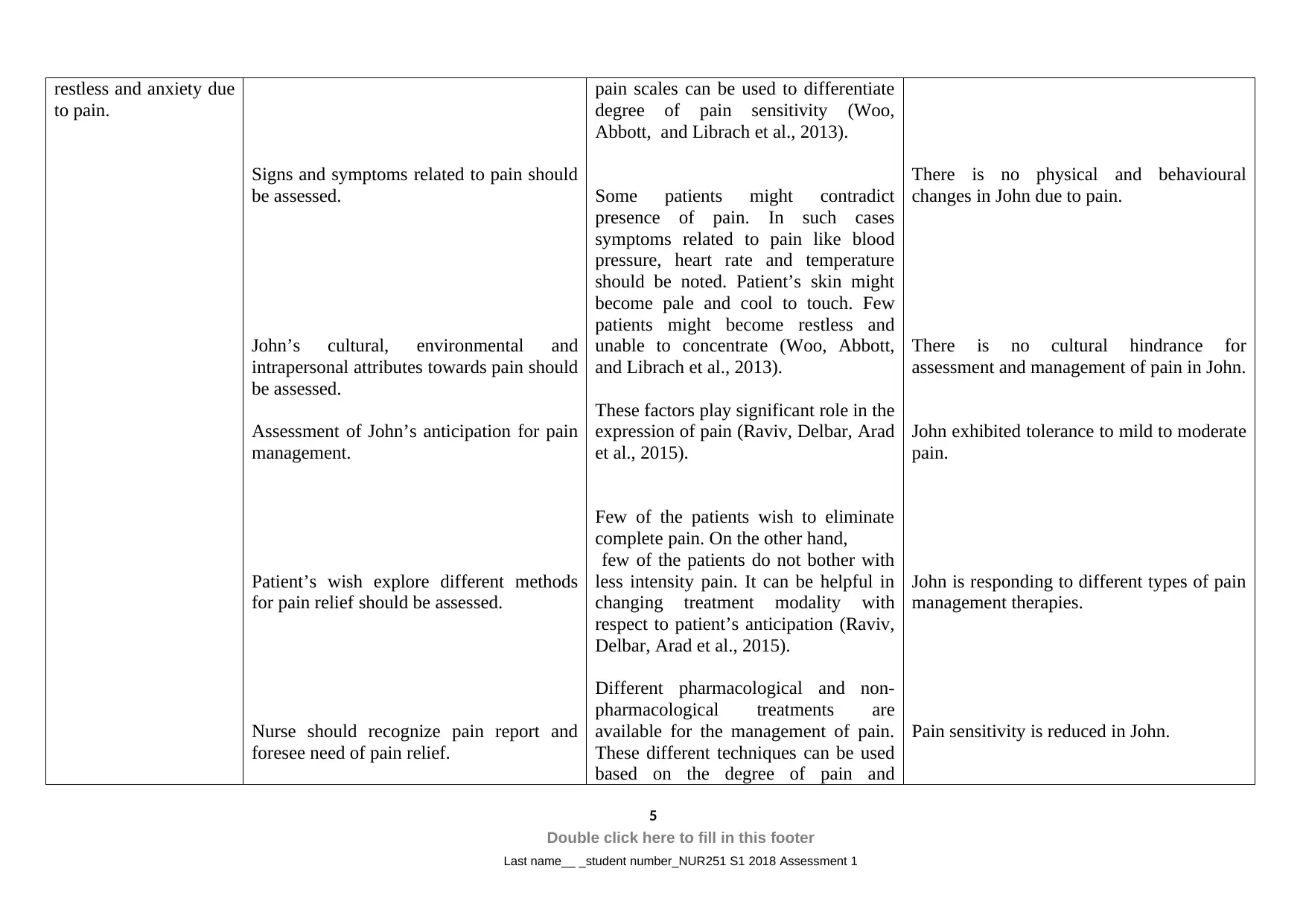
restless and anxiety due
to pain.
Signs and symptoms related to pain should
be assessed.
John’s cultural, environmental and
intrapersonal attributes towards pain should
be assessed.
Assessment of John’s anticipation for pain
management.
Patient’s wish explore different methods
for pain relief should be assessed.
Nurse should recognize pain report and
foresee need of pain relief.
pain scales can be used to differentiate
degree of pain sensitivity (Woo,
Abbott, and Librach et al., 2013).
Some patients might contradict
presence of pain. In such cases
symptoms related to pain like blood
pressure, heart rate and temperature
should be noted. Patient’s skin might
become pale and cool to touch. Few
patients might become restless and
unable to concentrate (Woo, Abbott,
and Librach et al., 2013).
These factors play significant role in the
expression of pain (Raviv, Delbar, Arad
et al., 2015).
Few of the patients wish to eliminate
complete pain. On the other hand,
few of the patients do not bother with
less intensity pain. It can be helpful in
changing treatment modality with
respect to patient’s anticipation (Raviv,
Delbar, Arad et al., 2015).
Different pharmacological and non-
pharmacological treatments are
available for the management of pain.
These different techniques can be used
based on the degree of pain and
There is no physical and behavioural
changes in John due to pain.
There is no cultural hindrance for
assessment and management of pain in John.
John exhibited tolerance to mild to moderate
pain.
John is responding to different types of pain
management therapies.
Pain sensitivity is reduced in John.
5
Double click here to fill in this footer
Last name__ _student number_NUR251 S1 2018 Assessment 1
to pain.
Signs and symptoms related to pain should
be assessed.
John’s cultural, environmental and
intrapersonal attributes towards pain should
be assessed.
Assessment of John’s anticipation for pain
management.
Patient’s wish explore different methods
for pain relief should be assessed.
Nurse should recognize pain report and
foresee need of pain relief.
pain scales can be used to differentiate
degree of pain sensitivity (Woo,
Abbott, and Librach et al., 2013).
Some patients might contradict
presence of pain. In such cases
symptoms related to pain like blood
pressure, heart rate and temperature
should be noted. Patient’s skin might
become pale and cool to touch. Few
patients might become restless and
unable to concentrate (Woo, Abbott,
and Librach et al., 2013).
These factors play significant role in the
expression of pain (Raviv, Delbar, Arad
et al., 2015).
Few of the patients wish to eliminate
complete pain. On the other hand,
few of the patients do not bother with
less intensity pain. It can be helpful in
changing treatment modality with
respect to patient’s anticipation (Raviv,
Delbar, Arad et al., 2015).
Different pharmacological and non-
pharmacological treatments are
available for the management of pain.
These different techniques can be used
based on the degree of pain and
There is no physical and behavioural
changes in John due to pain.
There is no cultural hindrance for
assessment and management of pain in John.
John exhibited tolerance to mild to moderate
pain.
John is responding to different types of pain
management therapies.
Pain sensitivity is reduced in John.
5
Double click here to fill in this footer
Last name__ _student number_NUR251 S1 2018 Assessment 1
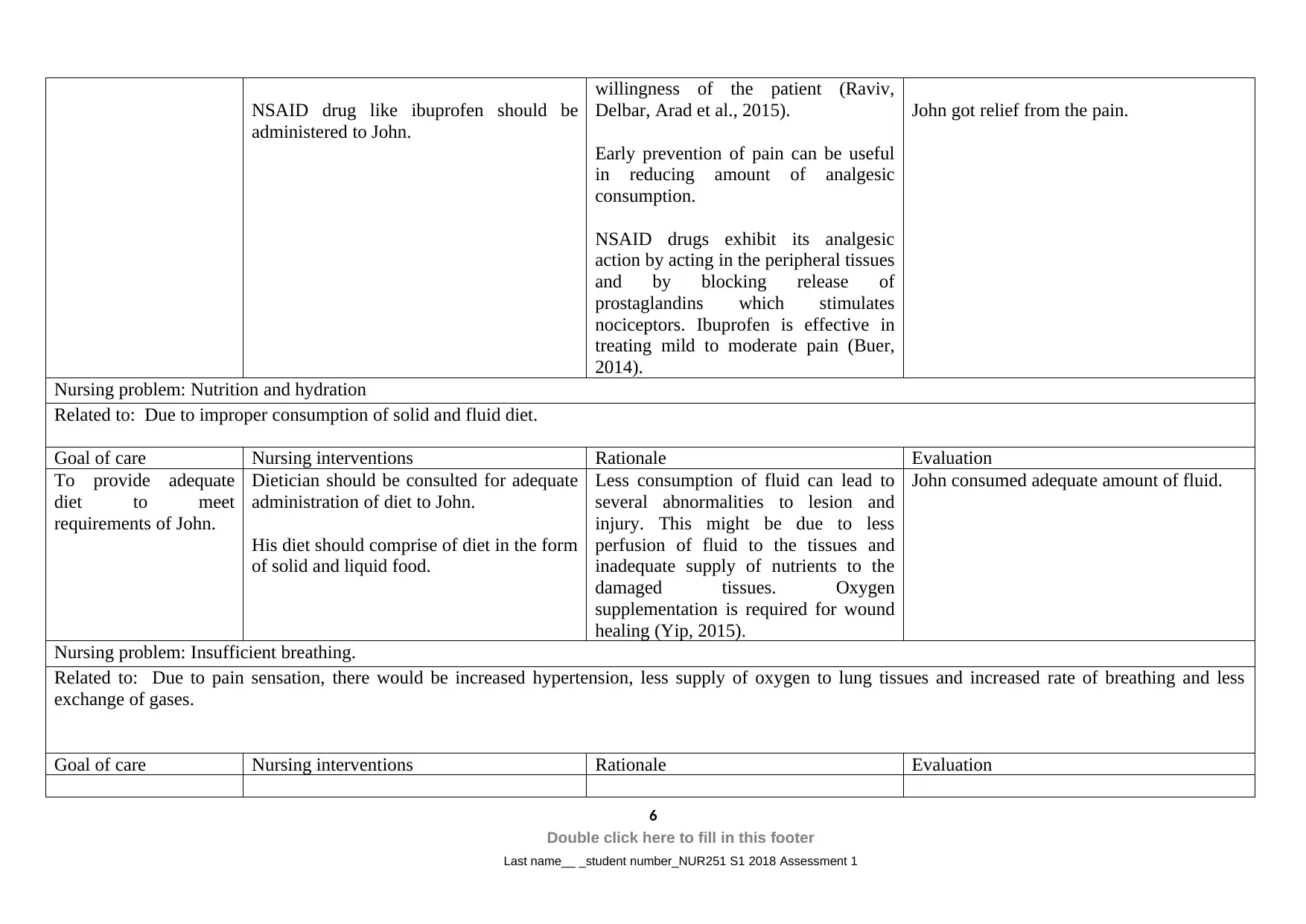
NSAID drug like ibuprofen should be
administered to John.
willingness of the patient (Raviv,
Delbar, Arad et al., 2015).
Early prevention of pain can be useful
in reducing amount of analgesic
consumption.
NSAID drugs exhibit its analgesic
action by acting in the peripheral tissues
and by blocking release of
prostaglandins which stimulates
nociceptors. Ibuprofen is effective in
treating mild to moderate pain (Buer,
2014).
John got relief from the pain.
Nursing problem: Nutrition and hydration
Related to: Due to improper consumption of solid and fluid diet.
Goal of care Nursing interventions Rationale Evaluation
To provide adequate
diet to meet
requirements of John.
Dietician should be consulted for adequate
administration of diet to John.
His diet should comprise of diet in the form
of solid and liquid food.
Less consumption of fluid can lead to
several abnormalities to lesion and
injury. This might be due to less
perfusion of fluid to the tissues and
inadequate supply of nutrients to the
damaged tissues. Oxygen
supplementation is required for wound
healing (Yip, 2015).
John consumed adequate amount of fluid.
Nursing problem: Insufficient breathing.
Related to: Due to pain sensation, there would be increased hypertension, less supply of oxygen to lung tissues and increased rate of breathing and less
exchange of gases.
Goal of care Nursing interventions Rationale Evaluation
6
Double click here to fill in this footer
Last name__ _student number_NUR251 S1 2018 Assessment 1
administered to John.
willingness of the patient (Raviv,
Delbar, Arad et al., 2015).
Early prevention of pain can be useful
in reducing amount of analgesic
consumption.
NSAID drugs exhibit its analgesic
action by acting in the peripheral tissues
and by blocking release of
prostaglandins which stimulates
nociceptors. Ibuprofen is effective in
treating mild to moderate pain (Buer,
2014).
John got relief from the pain.
Nursing problem: Nutrition and hydration
Related to: Due to improper consumption of solid and fluid diet.
Goal of care Nursing interventions Rationale Evaluation
To provide adequate
diet to meet
requirements of John.
Dietician should be consulted for adequate
administration of diet to John.
His diet should comprise of diet in the form
of solid and liquid food.
Less consumption of fluid can lead to
several abnormalities to lesion and
injury. This might be due to less
perfusion of fluid to the tissues and
inadequate supply of nutrients to the
damaged tissues. Oxygen
supplementation is required for wound
healing (Yip, 2015).
John consumed adequate amount of fluid.
Nursing problem: Insufficient breathing.
Related to: Due to pain sensation, there would be increased hypertension, less supply of oxygen to lung tissues and increased rate of breathing and less
exchange of gases.
Goal of care Nursing interventions Rationale Evaluation
6
Double click here to fill in this footer
Last name__ _student number_NUR251 S1 2018 Assessment 1
⊘ This is a preview!⊘
Do you want full access?
Subscribe today to unlock all pages.

Trusted by 1+ million students worldwide

Respiratory rate should
be normal in case of
John.
Assessment of respiratory rate in John.
Determine ABG in John.
Provide supplemental oxygen to John.
Teach breathing techniques to John.
Teach relaxation techniques for John.
Early assessment of respiratory rate in
John can be helpful in planning early
care plan (Gulanick and Myers, 2016;
Potter, Perry, Stockert et al., 2013).
Determination of ABG can be helpful
in assessing gaseous exchange at the
alveoli and capillary interface
(Gulanick and Myers, 2016; Potter,
Perry, Stockert et al., 2013).
Supplemental oxygen would be helpful
in the maintaining optimum oxygen
saturation (Gulanick and Myers, 2016;
Potter, Perry, Stockert et al., 2013).
Teaching of breathing and relaxation
techniques would be helpful in
improving breathing pattern in John
(Gulanick and Myers, 2016; Potter,
Perry, Stockert et al., 2013).
Intervention for improving breathing
intervention initiated early in the treatment
phase.
Optimum amount oxygen saturation
maintained in the blood.
Oxygen saturation improved due to
supplemental oxygen.
Improvement in the breathing pattern
observed in case of John.
Nursing problem: Anxiety.
Related to: Due to injury and pain sensation, John might become anxious.
Goal of care Nursing interventions Rationale Evaluation
John should describe
own anxiety and coping
method.
Assessment of level of anxiety like mild,
moderate, severe and panic.
Assessment of physical reactions to
Assessment of level of anxiety can be
helpful in providing appropriate care
plan (Gulanick and Myers, 2016)
Anxiety can cause symptoms like
Improved thought process in John.
John can monitor signs and symptoms of
7
Double click here to fill in this footer
Last name__ _student number_NUR251 S1 2018 Assessment 1
be normal in case of
John.
Assessment of respiratory rate in John.
Determine ABG in John.
Provide supplemental oxygen to John.
Teach breathing techniques to John.
Teach relaxation techniques for John.
Early assessment of respiratory rate in
John can be helpful in planning early
care plan (Gulanick and Myers, 2016;
Potter, Perry, Stockert et al., 2013).
Determination of ABG can be helpful
in assessing gaseous exchange at the
alveoli and capillary interface
(Gulanick and Myers, 2016; Potter,
Perry, Stockert et al., 2013).
Supplemental oxygen would be helpful
in the maintaining optimum oxygen
saturation (Gulanick and Myers, 2016;
Potter, Perry, Stockert et al., 2013).
Teaching of breathing and relaxation
techniques would be helpful in
improving breathing pattern in John
(Gulanick and Myers, 2016; Potter,
Perry, Stockert et al., 2013).
Intervention for improving breathing
intervention initiated early in the treatment
phase.
Optimum amount oxygen saturation
maintained in the blood.
Oxygen saturation improved due to
supplemental oxygen.
Improvement in the breathing pattern
observed in case of John.
Nursing problem: Anxiety.
Related to: Due to injury and pain sensation, John might become anxious.
Goal of care Nursing interventions Rationale Evaluation
John should describe
own anxiety and coping
method.
Assessment of level of anxiety like mild,
moderate, severe and panic.
Assessment of physical reactions to
Assessment of level of anxiety can be
helpful in providing appropriate care
plan (Gulanick and Myers, 2016)
Anxiety can cause symptoms like
Improved thought process in John.
John can monitor signs and symptoms of
7
Double click here to fill in this footer
Last name__ _student number_NUR251 S1 2018 Assessment 1
Paraphrase This Document
Need a fresh take? Get an instant paraphrase of this document with our AI Paraphraser
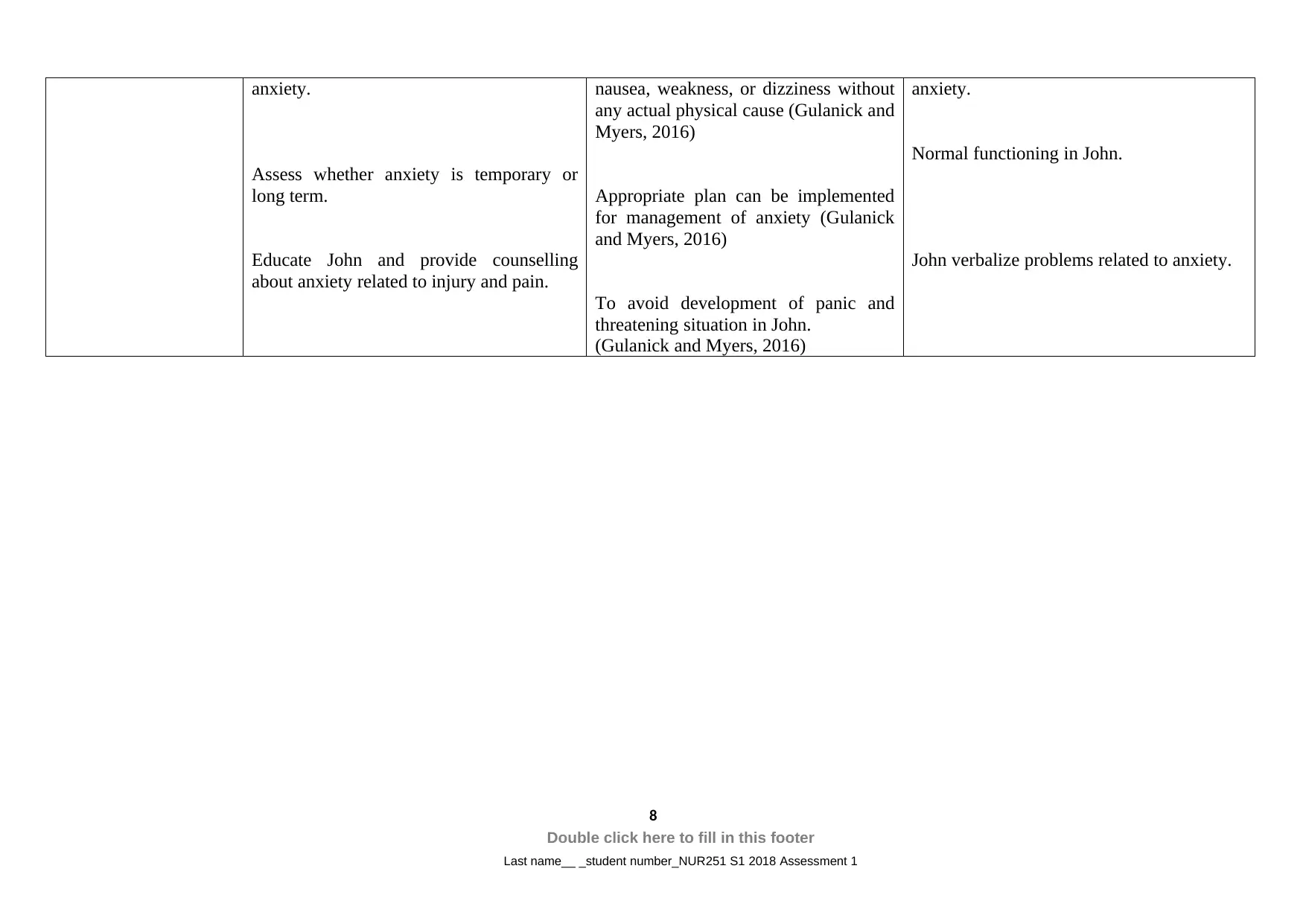
anxiety.
Assess whether anxiety is temporary or
long term.
Educate John and provide counselling
about anxiety related to injury and pain.
nausea, weakness, or dizziness without
any actual physical cause (Gulanick and
Myers, 2016)
Appropriate plan can be implemented
for management of anxiety (Gulanick
and Myers, 2016)
To avoid development of panic and
threatening situation in John.
(Gulanick and Myers, 2016)
anxiety.
Normal functioning in John.
John verbalize problems related to anxiety.
8
Double click here to fill in this footer
Last name__ _student number_NUR251 S1 2018 Assessment 1
Assess whether anxiety is temporary or
long term.
Educate John and provide counselling
about anxiety related to injury and pain.
nausea, weakness, or dizziness without
any actual physical cause (Gulanick and
Myers, 2016)
Appropriate plan can be implemented
for management of anxiety (Gulanick
and Myers, 2016)
To avoid development of panic and
threatening situation in John.
(Gulanick and Myers, 2016)
anxiety.
Normal functioning in John.
John verbalize problems related to anxiety.
8
Double click here to fill in this footer
Last name__ _student number_NUR251 S1 2018 Assessment 1
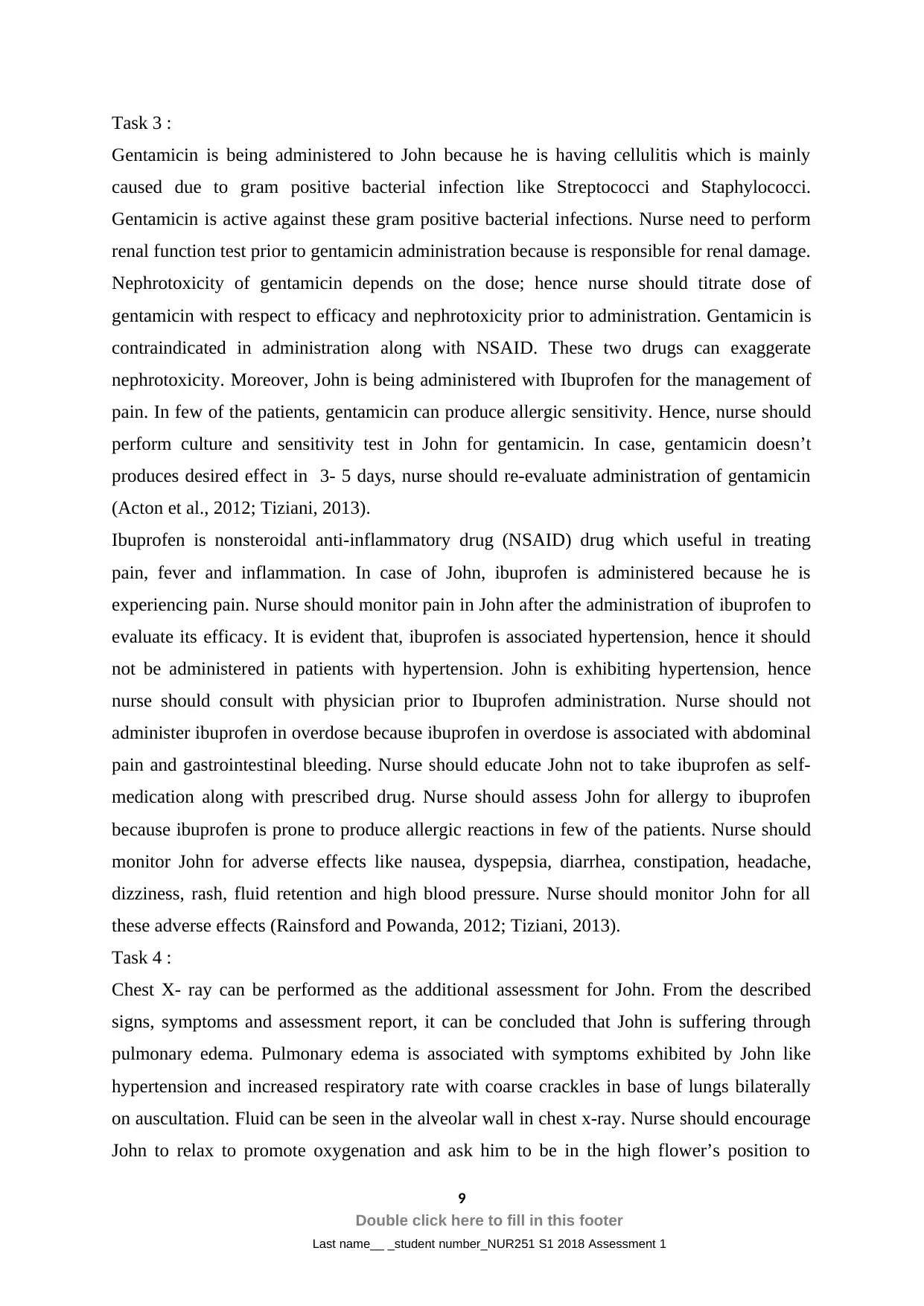
Task 3 :
Gentamicin is being administered to John because he is having cellulitis which is mainly
caused due to gram positive bacterial infection like Streptococci and Staphylococci.
Gentamicin is active against these gram positive bacterial infections. Nurse need to perform
renal function test prior to gentamicin administration because is responsible for renal damage.
Nephrotoxicity of gentamicin depends on the dose; hence nurse should titrate dose of
gentamicin with respect to efficacy and nephrotoxicity prior to administration. Gentamicin is
contraindicated in administration along with NSAID. These two drugs can exaggerate
nephrotoxicity. Moreover, John is being administered with Ibuprofen for the management of
pain. In few of the patients, gentamicin can produce allergic sensitivity. Hence, nurse should
perform culture and sensitivity test in John for gentamicin. In case, gentamicin doesn’t
produces desired effect in 3- 5 days, nurse should re-evaluate administration of gentamicin
(Acton et al., 2012; Tiziani, 2013).
Ibuprofen is nonsteroidal anti-inflammatory drug (NSAID) drug which useful in treating
pain, fever and inflammation. In case of John, ibuprofen is administered because he is
experiencing pain. Nurse should monitor pain in John after the administration of ibuprofen to
evaluate its efficacy. It is evident that, ibuprofen is associated hypertension, hence it should
not be administered in patients with hypertension. John is exhibiting hypertension, hence
nurse should consult with physician prior to Ibuprofen administration. Nurse should not
administer ibuprofen in overdose because ibuprofen in overdose is associated with abdominal
pain and gastrointestinal bleeding. Nurse should educate John not to take ibuprofen as self-
medication along with prescribed drug. Nurse should assess John for allergy to ibuprofen
because ibuprofen is prone to produce allergic reactions in few of the patients. Nurse should
monitor John for adverse effects like nausea, dyspepsia, diarrhea, constipation, headache,
dizziness, rash, fluid retention and high blood pressure. Nurse should monitor John for all
these adverse effects (Rainsford and Powanda, 2012; Tiziani, 2013).
Task 4 :
Chest X- ray can be performed as the additional assessment for John. From the described
signs, symptoms and assessment report, it can be concluded that John is suffering through
pulmonary edema. Pulmonary edema is associated with symptoms exhibited by John like
hypertension and increased respiratory rate with coarse crackles in base of lungs bilaterally
on auscultation. Fluid can be seen in the alveolar wall in chest x-ray. Nurse should encourage
John to relax to promote oxygenation and ask him to be in the high flower’s position to
9
Double click here to fill in this footer
Last name__ _student number_NUR251 S1 2018 Assessment 1
Gentamicin is being administered to John because he is having cellulitis which is mainly
caused due to gram positive bacterial infection like Streptococci and Staphylococci.
Gentamicin is active against these gram positive bacterial infections. Nurse need to perform
renal function test prior to gentamicin administration because is responsible for renal damage.
Nephrotoxicity of gentamicin depends on the dose; hence nurse should titrate dose of
gentamicin with respect to efficacy and nephrotoxicity prior to administration. Gentamicin is
contraindicated in administration along with NSAID. These two drugs can exaggerate
nephrotoxicity. Moreover, John is being administered with Ibuprofen for the management of
pain. In few of the patients, gentamicin can produce allergic sensitivity. Hence, nurse should
perform culture and sensitivity test in John for gentamicin. In case, gentamicin doesn’t
produces desired effect in 3- 5 days, nurse should re-evaluate administration of gentamicin
(Acton et al., 2012; Tiziani, 2013).
Ibuprofen is nonsteroidal anti-inflammatory drug (NSAID) drug which useful in treating
pain, fever and inflammation. In case of John, ibuprofen is administered because he is
experiencing pain. Nurse should monitor pain in John after the administration of ibuprofen to
evaluate its efficacy. It is evident that, ibuprofen is associated hypertension, hence it should
not be administered in patients with hypertension. John is exhibiting hypertension, hence
nurse should consult with physician prior to Ibuprofen administration. Nurse should not
administer ibuprofen in overdose because ibuprofen in overdose is associated with abdominal
pain and gastrointestinal bleeding. Nurse should educate John not to take ibuprofen as self-
medication along with prescribed drug. Nurse should assess John for allergy to ibuprofen
because ibuprofen is prone to produce allergic reactions in few of the patients. Nurse should
monitor John for adverse effects like nausea, dyspepsia, diarrhea, constipation, headache,
dizziness, rash, fluid retention and high blood pressure. Nurse should monitor John for all
these adverse effects (Rainsford and Powanda, 2012; Tiziani, 2013).
Task 4 :
Chest X- ray can be performed as the additional assessment for John. From the described
signs, symptoms and assessment report, it can be concluded that John is suffering through
pulmonary edema. Pulmonary edema is associated with symptoms exhibited by John like
hypertension and increased respiratory rate with coarse crackles in base of lungs bilaterally
on auscultation. Fluid can be seen in the alveolar wall in chest x-ray. Nurse should encourage
John to relax to promote oxygenation and ask him to be in the high flower’s position to
9
Double click here to fill in this footer
Last name__ _student number_NUR251 S1 2018 Assessment 1
⊘ This is a preview!⊘
Do you want full access?
Subscribe today to unlock all pages.

Trusted by 1+ million students worldwide

enable expansion of lung. Nurse should monitor electrolyte balance and assess vital signs on
the regular basis. Nurse should monitor ABG in John and supplement with the artificial
oxygen. Diuretics can be prescribed for John. It can be helpful to reduce amount of fluid into
the arteries and veins and to allow flow of fluid from lungs to the blood circulation. Bipap
machine can be used to create artificial pressure in the lungs. It can be helpful in pushing
fluid from the air sacs which is useful in opening of these sacs. Opening of air sacs can be
helpful in improving gaseous exchange. Fluid rich diet should be restricted to John.
Deterioration of John could have been prevented by immediate supplementation of artificial
oxygen and maintenance of blood pressure. Maintenance of blood pressure could have been
useful in supplying adequate amount of blood to the vital organs and maintaining its proper
functioning (Jardins and Burton, 2015; Beachey, 2018; Lemone et al., 2017).
Task 5 :
John need to consume all the prescribed medications at the scheduled time. John is having
infection and antibiotics complete cycle need to be completed. Otherwise, it could lead to the
development of resistance to the to the infected bacteria. It is evident that John is being
experiencing anxiety since long time. Anxiety can lead to non-adherence to the medication.
Moreover, John is having hypertension and breathing problem. It might lead to depressive
like behaviour in John. Hence, John need to follow relaxation techniques to reduce
depression and anxiety. John is experiencing pain due to the wound. However, he should try
to keep his attention away from the pain because it can lead to stressful condition in him. This
stressful condition can exaggerate his breathing in-efficiency and hypertension. He should
maintain hygienic condition around his wound. It can be helpful in speedy wound healing and
prevention of spread of infection (Morton and Fontaine, 2017; Lemone et al., 2017). John can
go through different websites like medicine information centre, drug information centre, and
medicine and therapeutic information centre. John also can discuss with medical
professionals to get more information.
10
Double click here to fill in this footer
Last name__ _student number_NUR251 S1 2018 Assessment 1
the regular basis. Nurse should monitor ABG in John and supplement with the artificial
oxygen. Diuretics can be prescribed for John. It can be helpful to reduce amount of fluid into
the arteries and veins and to allow flow of fluid from lungs to the blood circulation. Bipap
machine can be used to create artificial pressure in the lungs. It can be helpful in pushing
fluid from the air sacs which is useful in opening of these sacs. Opening of air sacs can be
helpful in improving gaseous exchange. Fluid rich diet should be restricted to John.
Deterioration of John could have been prevented by immediate supplementation of artificial
oxygen and maintenance of blood pressure. Maintenance of blood pressure could have been
useful in supplying adequate amount of blood to the vital organs and maintaining its proper
functioning (Jardins and Burton, 2015; Beachey, 2018; Lemone et al., 2017).
Task 5 :
John need to consume all the prescribed medications at the scheduled time. John is having
infection and antibiotics complete cycle need to be completed. Otherwise, it could lead to the
development of resistance to the to the infected bacteria. It is evident that John is being
experiencing anxiety since long time. Anxiety can lead to non-adherence to the medication.
Moreover, John is having hypertension and breathing problem. It might lead to depressive
like behaviour in John. Hence, John need to follow relaxation techniques to reduce
depression and anxiety. John is experiencing pain due to the wound. However, he should try
to keep his attention away from the pain because it can lead to stressful condition in him. This
stressful condition can exaggerate his breathing in-efficiency and hypertension. He should
maintain hygienic condition around his wound. It can be helpful in speedy wound healing and
prevention of spread of infection (Morton and Fontaine, 2017; Lemone et al., 2017). John can
go through different websites like medicine information centre, drug information centre, and
medicine and therapeutic information centre. John also can discuss with medical
professionals to get more information.
10
Double click here to fill in this footer
Last name__ _student number_NUR251 S1 2018 Assessment 1
Paraphrase This Document
Need a fresh take? Get an instant paraphrase of this document with our AI Paraphraser
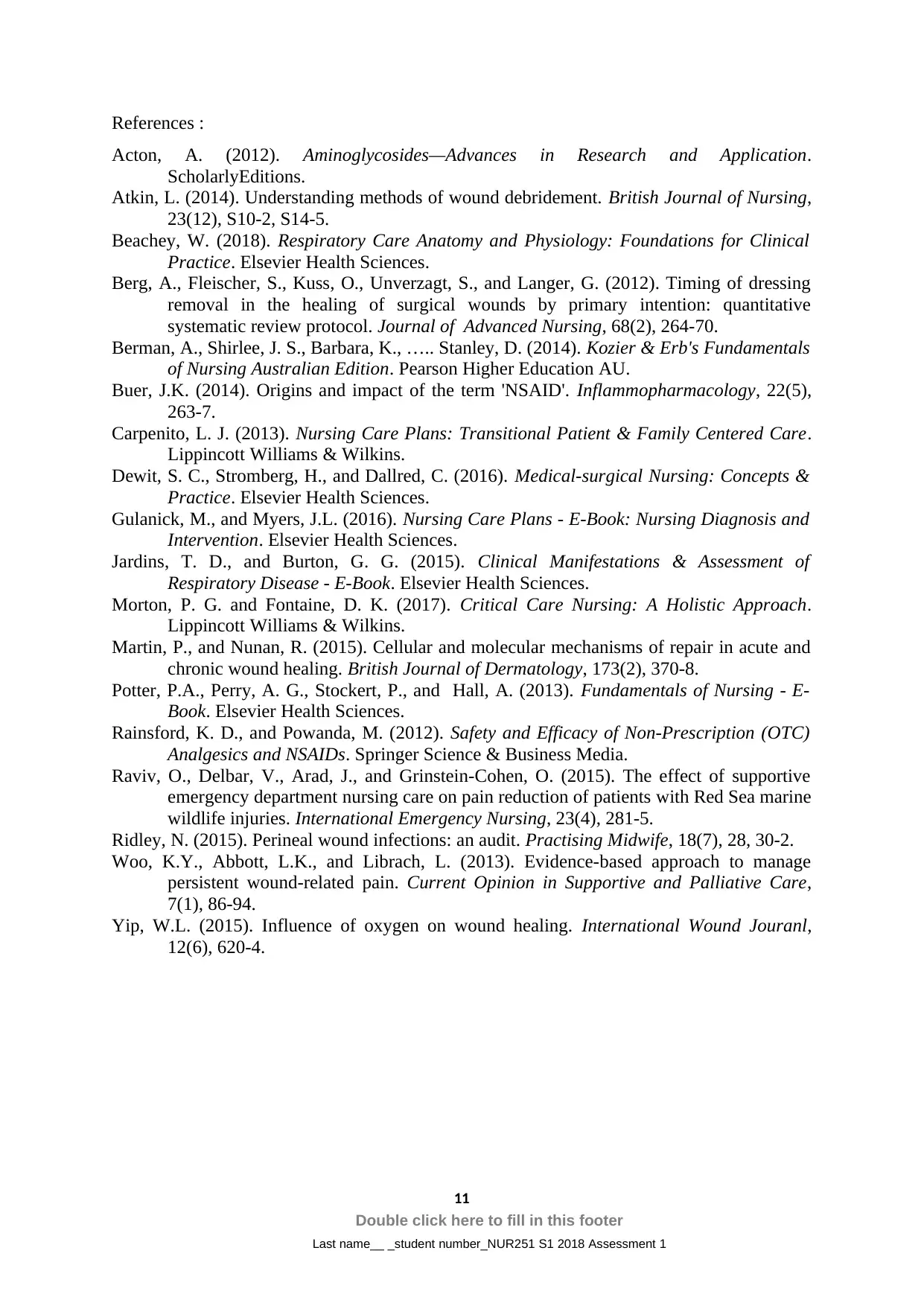
References :
Acton, A. (2012). Aminoglycosides—Advances in Research and Application.
ScholarlyEditions.
Atkin, L. (2014). Understanding methods of wound debridement. British Journal of Nursing,
23(12), S10-2, S14-5.
Beachey, W. (2018). Respiratory Care Anatomy and Physiology: Foundations for Clinical
Practice. Elsevier Health Sciences.
Berg, A., Fleischer, S., Kuss, O., Unverzagt, S., and Langer, G. (2012). Timing of dressing
removal in the healing of surgical wounds by primary intention: quantitative
systematic review protocol. Journal of Advanced Nursing, 68(2), 264-70.
Berman, A., Shirlee, J. S., Barbara, K., ….. Stanley, D. (2014). Kozier & Erb's Fundamentals
of Nursing Australian Edition. Pearson Higher Education AU.
Buer, J.K. (2014). Origins and impact of the term 'NSAID'. Inflammopharmacology, 22(5),
263-7.
Carpenito, L. J. (2013). Nursing Care Plans: Transitional Patient & Family Centered Care.
Lippincott Williams & Wilkins.
Dewit, S. C., Stromberg, H., and Dallred, C. (2016). Medical-surgical Nursing: Concepts &
Practice. Elsevier Health Sciences.
Gulanick, M., and Myers, J.L. (2016). Nursing Care Plans - E-Book: Nursing Diagnosis and
Intervention. Elsevier Health Sciences.
Jardins, T. D., and Burton, G. G. (2015). Clinical Manifestations & Assessment of
Respiratory Disease - E-Book. Elsevier Health Sciences.
Morton, P. G. and Fontaine, D. K. (2017). Critical Care Nursing: A Holistic Approach.
Lippincott Williams & Wilkins.
Martin, P., and Nunan, R. (2015). Cellular and molecular mechanisms of repair in acute and
chronic wound healing. British Journal of Dermatology, 173(2), 370-8.
Potter, P.A., Perry, A. G., Stockert, P., and Hall, A. (2013). Fundamentals of Nursing - E-
Book. Elsevier Health Sciences.
Rainsford, K. D., and Powanda, M. (2012). Safety and Efficacy of Non-Prescription (OTC)
Analgesics and NSAIDs. Springer Science & Business Media.
Raviv, O., Delbar, V., Arad, J., and Grinstein-Cohen, O. (2015). The effect of supportive
emergency department nursing care on pain reduction of patients with Red Sea marine
wildlife injuries. International Emergency Nursing, 23(4), 281-5.
Ridley, N. (2015). Perineal wound infections: an audit. Practising Midwife, 18(7), 28, 30-2.
Woo, K.Y., Abbott, L.K., and Librach, L. (2013). Evidence-based approach to manage
persistent wound-related pain. Current Opinion in Supportive and Palliative Care,
7(1), 86-94.
Yip, W.L. (2015). Influence of oxygen on wound healing. International Wound Jouranl,
12(6), 620-4.
11
Double click here to fill in this footer
Last name__ _student number_NUR251 S1 2018 Assessment 1
Acton, A. (2012). Aminoglycosides—Advances in Research and Application.
ScholarlyEditions.
Atkin, L. (2014). Understanding methods of wound debridement. British Journal of Nursing,
23(12), S10-2, S14-5.
Beachey, W. (2018). Respiratory Care Anatomy and Physiology: Foundations for Clinical
Practice. Elsevier Health Sciences.
Berg, A., Fleischer, S., Kuss, O., Unverzagt, S., and Langer, G. (2012). Timing of dressing
removal in the healing of surgical wounds by primary intention: quantitative
systematic review protocol. Journal of Advanced Nursing, 68(2), 264-70.
Berman, A., Shirlee, J. S., Barbara, K., ….. Stanley, D. (2014). Kozier & Erb's Fundamentals
of Nursing Australian Edition. Pearson Higher Education AU.
Buer, J.K. (2014). Origins and impact of the term 'NSAID'. Inflammopharmacology, 22(5),
263-7.
Carpenito, L. J. (2013). Nursing Care Plans: Transitional Patient & Family Centered Care.
Lippincott Williams & Wilkins.
Dewit, S. C., Stromberg, H., and Dallred, C. (2016). Medical-surgical Nursing: Concepts &
Practice. Elsevier Health Sciences.
Gulanick, M., and Myers, J.L. (2016). Nursing Care Plans - E-Book: Nursing Diagnosis and
Intervention. Elsevier Health Sciences.
Jardins, T. D., and Burton, G. G. (2015). Clinical Manifestations & Assessment of
Respiratory Disease - E-Book. Elsevier Health Sciences.
Morton, P. G. and Fontaine, D. K. (2017). Critical Care Nursing: A Holistic Approach.
Lippincott Williams & Wilkins.
Martin, P., and Nunan, R. (2015). Cellular and molecular mechanisms of repair in acute and
chronic wound healing. British Journal of Dermatology, 173(2), 370-8.
Potter, P.A., Perry, A. G., Stockert, P., and Hall, A. (2013). Fundamentals of Nursing - E-
Book. Elsevier Health Sciences.
Rainsford, K. D., and Powanda, M. (2012). Safety and Efficacy of Non-Prescription (OTC)
Analgesics and NSAIDs. Springer Science & Business Media.
Raviv, O., Delbar, V., Arad, J., and Grinstein-Cohen, O. (2015). The effect of supportive
emergency department nursing care on pain reduction of patients with Red Sea marine
wildlife injuries. International Emergency Nursing, 23(4), 281-5.
Ridley, N. (2015). Perineal wound infections: an audit. Practising Midwife, 18(7), 28, 30-2.
Woo, K.Y., Abbott, L.K., and Librach, L. (2013). Evidence-based approach to manage
persistent wound-related pain. Current Opinion in Supportive and Palliative Care,
7(1), 86-94.
Yip, W.L. (2015). Influence of oxygen on wound healing. International Wound Jouranl,
12(6), 620-4.
11
Double click here to fill in this footer
Last name__ _student number_NUR251 S1 2018 Assessment 1
1 out of 11
Related Documents
Your All-in-One AI-Powered Toolkit for Academic Success.
+13062052269
info@desklib.com
Available 24*7 on WhatsApp / Email
![[object Object]](/_next/static/media/star-bottom.7253800d.svg)
Unlock your academic potential
Copyright © 2020–2025 A2Z Services. All Rights Reserved. Developed and managed by ZUCOL.





